Development of Importance Measures Reflecting the Risk Triplet in Dynamic Probabilistic Risk Assessment: A Case Study Using MELCOR and RAPID †
Abstract
1. Introduction
2. Investigation of Importance Measures and Their Regulatory Applications
2.1. Traditional Risk Importance Measures
- Birnbaum importance reflects how frequently a component is involved in minimal cut sets (MCSs) leading to system failure, providing an absolute sensitivity metric purely based on system structure.
- Criticality importance quantifies the change in system failure probability due to perturbations in the failure probability of a component, again as an absolute measure.
- FV is a relative measure indicating the proportion of total system risk attributable to failure paths involving the component. FV is often used to identify components whose failure paths are dominant contributors to risk, useful in prioritizing inspection or system upgrades.
- RRW represents the decrease in system risk when a component is assumed to operate with perfect reliability. RRW helps to identify components where enhanced reliability would yield the most risk reduction, guiding system redesign or upgrade decisions.
- RAW quantifies the increase in system risk when a component is assumed to fail with certainty, relative to the baseline condition. RAW is essential for highlighting components whose failure would significantly degrade safety, supporting preventive maintenance strategies.
| RIM | Definition | Interpretation and Comments |
|---|---|---|
| Birnbaum | Absolute measure; is needed to prevent system failure. | |
| Criticality | Absolute measure; . | |
| FV | Dimensionless and relative measure; . | |
| RRW | Dimensionless and relative measure; . | |
| RAW | Dimensionless and relative measure; . |
2.2. Regulatory Applications of Risk Importance Measures
- In the categorization of SSCs under 10 CFR 50.69, FV and RAW are used to assign components into safety significance categories, thereby influencing requirements for inspection, maintenance, and quality assurance.
- For technical specification changes (10 CFR 50.59, RG 1.177), incremental CDF (ICDF) and incremental LERF (ILERF) are evaluated to support changes in surveillance frequency (SF) and allowed outage time (AOT).
- Under the maintenance rule (10 CFR 50.65), FV, RAW, and RRW are used to identify critical components for reliability-centered maintenance strategies.
- The reactor oversight process (ROP) utilizes these RIMs to support the significance determination process (SDP), which classifies inspection findings by their risk significance. The ROP approach has also been introduced by the JNRA as part of Japan’s regulatory modernization.
- In the licensing of small modular reactors (SMRs), risk insights derived from RIMs are employed to assess the adequacy of safety design features and proposed regulatory exemptions.
2.3. Risk-Triplet-Based Importance Measures for Dynamic PRA
- TBW (Timing-Based Worth): Reflects the relative delay or advancement in the expected time to an adverse end state (e.g., core damage or source term release) due to a basic event. Note that the expectations and conditional expectations in the numerators and denominators of Equations (2)–(4) are intentionally structured and differ in order. Specifically, Equation (2) is formulated such that a TBW value greater than 1 indicates that the failure of the component tends to accelerate the progression toward adverse end states. This design emphasizes the component’s temporal significance in the context of accident evolution and underscores its importance from a timing-based perspective.
- FBW (Frequency-Based Worth): Represents the change in frequency or probability of the adverse end state due to the event, analogous to FV or RAW.
- CBW (Consequence-Based Worth): Measures the variation in radiological consequence (e.g., source term release magnitude) due to the event.
- : Expected timing of end state (e.g., source term release),
- : Expected frequency of the end state,
- : Expected consequence (e.g., source term magnitude),
- , , : The conditional expectations are computed assuming the occurrence of basic event .
3. JAEA’s Dynamic PRA Approach and Computational Tool
3.1. Overview of the Dynamic PRA Approach
3.2. The RAPID Tool for Dynamic PRA Implementation
4. Trial Measurement of the Proposed Risk Metrics Using Level 2 Dynamic PRA
4.1. Scenario Setup and Model Description
4.2. Simulation Process and Computational Enhancements
- (1)
- Sequence generation using Monte Carlo sampling
- (2)
- Multi-fidelity simulation using MELCOR and a machine learning surrogate
- (3)
- Post-processing for risk characterization
- (4)
- Completeness check via probability distribution convergence
4.3. Risk Importance Measure Evaluation and Results
- The heading of “Containment Isolation or Not Bypass” exhibits the highest FBW (298.1) and CBW (3.707), emphasizing its critical function as the last barrier preventing uncontrolled release of radionuclides. Failure to isolate the containment significantly increases both the probability and magnitude of radiological consequences due to direct bypass paths.
- For the heading of “No Containment Overpressure Failure”, FBW is also high (59.61) and CBW is notably low (0.289), suggesting that overpressure failures tend to result in more gradual or filtered releases compared to bypass failures. TBW < 1 (0.971) indicates that the overpressure failure tends to occur later than the containment bypass.
- This mitigation systems of “HPCI or RCIC” have a prominent TBW of 1.656, confirming its effectiveness in delaying core damage and source term release. Although FBW (19.28) is substantial, CBW (0.990) remains near unity, indicating neutral impact on consequence magnitude, consistent with its delay-oriented function.
- The heading of “Offsite or EDGs Recovery” shows substantial FBW (71.5), with TBW and CBW values close to 1.0, implying their primary contribution lies in reducing the frequency of severe accidents, rather than influencing timing or consequence severity.
- The heading of “SRV Close” shows modest TBW (1.044) and FBW (4.888), with a relatively low CBW (1.156), suggesting only a limited role in altering release conditions compared to containment-related events.
5. Conclusions and Future Work
- Traditional RIMs have shown applicability in nuclear regulation; for instance, the risk-informed categorization of SSCs, risk-informed changes to technical specifications, application of maintenance rule, the reactor oversight process, which has also been introduced to the regulatory system by the JNRA, and licensing application activities of small modular reactors, to name a few. While traditional RIMs offer valuable insights, they primarily reflect frequency-based influence. They often fall short in addressing time-critical mitigation actions or consequence-limiting system behavior, which are increasingly important in RIDM, especially for severe accident management.
- The newly proposed RIMs enable a more nuanced characterization of component and system importance. TBW introduced a time-resolved dimension that proved valuable for identifying components and systems that delay the progression of severe accidents, which is particularly relevant for emergency response planning and mitigation timing. FBW aligned closely with traditional frequency-based importance measures, reaffirming its role in quantifying the probability of adverse outcomes. CBW added consequence sensitivity to the analysis, revealing which events and systems most influence the magnitude of radionuclide release.
- The proposed risk-triplet-based RIMs offer a more comprehensive foundation for RIDM by incorporating not only the probability of events but also the timing and severity of their consequences. This multidimensional perspective enables more informed system prioritization, particularly in applications such as severe accident management, design optimization for advanced reactors, and emergency response planning. By leveraging a simulation-driven framework, the approach is especially well-suited for evaluating emerging technologies, such as accident-tolerant fuels (ATFs), that exhibit enhanced performance in delaying core damage progression and reducing hydrogen generation. These new metrics enhance the realism and relevance of PRA results in guiding safety-focused innovation.
- This study also demonstrated the technical feasibility and practical utility of RAPID as a dynamic PRA platform capable of handling extensive simulations and integrating with deterministic analysis tools such as MELCOR. The use of surrogate modeling further expanded the scope of scenario coverage while maintaining computational efficiency, highlighting a scalable pathway for broader applications.
Author Contributions
Funding
Data Availability Statement
Acknowledgments
Conflicts of Interest
List of Abbreviations and Acronyms
| AOT | Allowed Outage Time |
| ATF | Accident Tolerant Fuel |
| BWR | Boiling Water Reactor |
| CBW | Consequence-Based Worth |
| CDF | Core Damage Frequency |
| CET | Containment Event Tree |
| CFR | Code of Federal Regulations |
| ET | Event Tree |
| FBW | Frequency-Based Worth |
| FT | Fault Trees |
| FV | Fussell-Vesely |
| HPC | High-Performance Computing |
| HPCI | High-Pressure Coolant Injection |
| ICDF | Incremental Core Damage Frequency |
| ICDP | Incremental Core Damage Probability |
| IDPSA | Integrated Deterministic and Probabilistic Safety Assessment |
| ILERF | Incremental Large Early Release Frequency |
| ILERP | Incremental Large Early Release Probability |
| JNRA | Nuclear Regulation Authority of Japan |
| LERF | Large Early Release Frequency |
| MCS | Minimal Cut Set |
| MELCOR | Methods of Estimation of Leakages and Consequences of Releases |
| MFMC | Multi-Fidelity Monte Carlo |
| PCT | Peak Cladding Temperature |
| PRA | Probabilistic Risk Assessment |
| PSAM 17& ASRAM2024 | The International Conference on Probabilistic Safety Assessment and Management 17 & Asian Symposium on Risk Assessment and Management 2024 |
| RAPID | Risk Assessment with Plant Interactive Dynamics |
| RAW | Risk Achievement Worth |
| RCIC | Reactor Core Isolation Cooling |
| RI-ISI | Risk-Informed In-Service Inspection |
| RIDM | Risk-Informed Decision Making |
| RIM | Risk Importance Measure |
| RIPB | Risk-Informed Performance-Based |
| RISC | Risk-Informed Safety Classes |
| RISMC | Risk-Informed Safety Margin Characterization |
| ROP | Reactor Oversight Process |
| RPV | Reactor Pressure Vessel |
| RRW | Risk Reduction Worth |
| SBO | Station Blackout |
| SDP | Significance Determination Process |
| SF | Surveillance Frequency |
| SMR | Small Modular Reactor |
| SRV | Safety Relief Valve |
| SSC | Structures, Systems, And Component |
| SVM | Support Vector Machine |
| TBW | Timing-Based Worth |
| UQ | Uncertainty Quantification |
| USNRC | U.S. Nuclear Regulatory Commission |
References
- Zheng, X.; Tamaki, H.; Sibamoto, Y.; Maruyama, Y.; Takada, T.; Narukawa, T.; Takata, T. Development of Risk Importance Measures for Dynamic PRA Based on Risk Triplet (2) Trial Measurement of Risk Importance Through Dynamic Level 2 PRA with RAPID. In Proceedings of the International Conference on Probabilistic Safety Assessment and Management & Asian Symposium on risk Assessment and Management (PSAM 17& ASRAM2024), Miyagi, Japan, 7–11 October 2024. [Google Scholar]
- United States General Accounting Office. Strategy Needed to Regulate Safety Using Information on Risk; GAO/RCED-99-95; United States General Accounting Office: Washington, DC, USA, 1999.
- Fuketa, T. Use of risk information in regulation. In Proceedings of the Atomic Energy Society of Japan 2015 Annual Meeting, Ibaraki, Japan, 20–22 March 2015. (In Japanese). [Google Scholar]
- U.S. Nuclear Regulatory Commission. Use of probabilistic risk assessment methods in nuclear regulatory activities, final policy statement. Fed. Regist. 1995, 60, 42622–42629. [Google Scholar]
- Nourbakhsh, H.P.; Apostolakis, G.; Powers, D.A. The evolution of the U.S. nuclear regulatory process. Prog. Nucl. Energy 2018, 102, 79–89. [Google Scholar] [CrossRef]
- U.S. Code of Federal Regulations. Title 10, Part 50, Section 50.65. Requirements for Monitoring the Effectiveness of Maintenance at Nuclear Power Plants. Available online: https://www.ecfr.gov/current/title-10/chapter-I/part-50/subject-group-ECFR2f76ac8b7f9e21e/section-50.65 (accessed on 30 April 2025).
- U.S. Nuclear Regulatory Commission. Reactor Oversight Process; NUREG-1649, Revision 6; U.S. Nuclear Regulatory Commission: Washington, DC, USA, 2016.
- U.S. Nuclear Regulatory Commission. An Approach for Using Probabilistic Risk Assessment in Risk-Informed Decisions on Plant-Specific Changes to the Licensing Basis; Regulatory Guide 1.174, Revision 3; U.S. Nuclear Regulatory Commission: Washington, DC, USA, 2018.
- U.S. Nuclear Regulatory Commission. Issues and Recommendations for Advancement of PRA Technology in Risk-Informed Decision Making; NUREG/CR-6813; U.S. Nuclear Regulatory Commission: Washington, DC, USA, 2003.
- U.S. Code of Federal Regulations. Title 10, Part 50, Section 50.69. Risk-Informed Categorization and Treatment of Structures, Systems and Components for Nuclear Power Reactors. Available online: https://www.ecfr.gov/current/title-10/chapter-I/part-50/subject-group-ECFR2f76ac8b7f9e21e/section-50.69 (accessed on 30 April 2025).
- U.S. Code of Federal Regulations. Title 10, Part 50, Section 50.48. Fire protection. Available online: https://www.ecfr.gov/current/title-10/chapter-I/part-50/subject-group-ECFRdf2af20f8a72d91/section-50.48 (accessed on 30 April 2025).
- Nuclear Energy Institute. 10 CFR 50.69 SSC categorization Guideline; Nuclear Energy Institute: Washington, DC, USA, 2005. [Google Scholar]
- Modarres, M.; Kaminskiy, M.P.; Krivtsov, V. Reliability Engineering and Risk Analysis: A Practical Guide, 3rd ed.; CRC Press: Boca Raton, FL, USA; Taylor & Francis Group: Abingdon, UK, 2017. [Google Scholar]
- Aldemir, T. A survey of dynamic methodologies for probabilistic safety assessment of nuclear power plants. Ann. Nucl. Energy 2013, 52, 113–124. [Google Scholar] [CrossRef]
- Mosleh, A. PRA: A perspective on strengths, current limitations, and possible improvements. Nucl. Eng. Technol. 2014, 46, 1–10. [Google Scholar] [CrossRef]
- Kaplan, S.; Garrick, B.J. On the quantitative definition of risk. Risk Anal. 1981, 1, 11–27. [Google Scholar] [CrossRef]
- Narukawa, T.; Takata, T.; Zheng, X.; Tamaki, H.; Sibamoto, Y.; Maruyama, Y.; Takada, T. Development of Risk Importance Measures for Dynamic PRA Based on Risk Triplet (1) the Concept and Measures of Risk Importance. In Proceedings of the International Conference on Probabilistic Safety Assessment and Management & Asian Symposium on Risk Assessment and Management (PSAM 17& ASRAM2024), Miyagi, Japan, 7–11 October 2024. [Google Scholar]
- Zheng, X.; Tamaki, H.; Sugiyama, T.; Maruyama, Y. Dynamic probabilistic risk assessment of nuclear power plants using multi-fidelity simulations. Reliab. Eng. Syst. Saf. 2022, 223, 108503. [Google Scholar] [CrossRef]
- Humphries, L.L.; Beeny, B.A.; Gelbard, F.; Louie, D.L.; Phillips, J. MELCOR Computer Code Manuals vol. 1: Primer and Users’ Guide, version 2.2.11932. SAND2018-13559 O; Sandia National Laboratories: Albuquerque, NM, USA, 2018.
- Vrbanic, I.; Samanta, P.; Basic, I. Risk Importance Measures in the Design and Operation of Nuclear Power Plants; BNL-114389-2017-BC; Brookhaven National Laboratory; The American Society of Mechanical Engineers (ASME): New York, NY, USA, 2017. [Google Scholar]
- Vesely, W.E.; Davis, T.C.; Denning, R.S.; Saltos, N. Measures of Risk Importance and Their Applications; NUREG/CR-3385; U.S. Nuclear Regulatory Commission: Washington, DC, USA, 1983.
- Vesely, W.E.; Davis, T.C. Two measures of risk importance and their application. Nucl. Technol. 1985, 68, 226–234. [Google Scholar] [CrossRef]
- Cheok, M.C.; Parry, G.W.; Sherry, R.R. Use of importance measures in risk-informed regulatory applications. Reliab. Eng. Syst. Saf. 1998, 60, 213–226. [Google Scholar] [CrossRef]
- U.S. Nuclear Regulatory Commission. Plant-Specific, risk-Informed Decisionmaking: Technical Specifications; Regulatory Guide 1.177, Revision 2; U.S. Nuclear Regulatory Commission: Washington, DC, USA, 2021.
- Nuclear Energy Institute. Risk-Informed Technical Specifications Initiative 4b Risk-Managed Technical Specifications (RMTS) Guidelines; NEI 06-09, Revision 0; Nuclear Energy Institute: Washington, DC, USA, 2006. [Google Scholar]
- Nuclear Energy Institute. Risk-Informed Technical Specifications Initiative 5b: Risk-Informed Method for Control of Surveillance Frequencies; NEI 04-10, Revision 0; Nuclear Energy Institute: Washington, DC, USA, 2006. [Google Scholar]
- U.S. Nuclear Regulatory Commission. Monitoring the Effectiveness of Maintenance at Nuclear Power Plants; Regulatory Guide 1.160, Revision 4; U.S. Nuclear Regulatory Commission: Washington, DC, USA, 2018.
- Nuclear Energy Institute. Industry Guideline for Monitoring the Effectiveness of Maintenance at Nuclear Power Plants; NUMARC 93-01, Revision 4; Nuclear Energy Institute: Washington, DC, USA, 2010. [Google Scholar]
- U.S. Nuclear Regulatory Commission. Inspection Manual, Manual Chapter 0609. Available online: https://www.nrc.gov/reading-rm/doc-collections/insp-manual/manual-chapter/index.html (accessed on 30 April 2025).
- U.S. Nuclear Regulatory Commission. Inspection Manual, Inspection Procedure 7111. Available online: https://www.nrc.gov/reading-rm/doc-collections/insp-manual/inspection-procedure/index.html (accessed on 30 April 2025).
- U.S. Nuclear Regulatory Commission. Licensing Activities for Small Modular Reactors. Available online: https://www.nrc.gov/reactors/new-reactors/advanced.html (accessed on 30 April 2025).
- Mandelli, D.; Ma, Z.; Parisi, C.; Alfonsi, A.; Smith, C. Measuring risk-importance in a dynamic PRA framework. Ann. Nucl. Energy 2019, 128, 160–170. [Google Scholar] [CrossRef]
- Zio, E. Integrated deterministic and probabilistic safety assessment: Concepts, challenges, research directions. Nucl. Eng. Des. 2014, 280, 413–419. [Google Scholar] [CrossRef]
- Smith, C.; Rabiti, C.; Szilard, R. Risk-Informed Safety Margins Characterization (RISMC) Pathway Technical Program Plan; INL/EXT-17-43243 Revision 0; Idaho National Laboratory: Idaho Falls, ID, USA, 2017. [Google Scholar]
- Mandelli, D.; Smith, C.; Riley, T.; Nielsen, J.; Alfonsi, A.; Cogliati, J.; Rabiti, C.; Schroeder, J. BWR station blackout: A RISMC analysis using RAVEN and RELAP5-3D. Nucl. Technol. 2016, 193, 161–174. [Google Scholar] [CrossRef]
- Pratt, W.T.; Mubayi, V.; Chu, T.L.; Martinez-Guridi, G.; Lehner, J. An Approach for Estimating the Frequencies of Various Containment Failure Modes and Bypass Events; NUREG/CR-6595, Rev. 1; U.S. Nuclear Regulatory Commission: Washington, DC, USA, 2004.
- Peherstorfer, B.; Willcox, K.; Gunzburger, M. Survey of multifidelity methods in uncertainty propagation, inference, and optimization. SIAM Rev. 2018, 60, 550–591. [Google Scholar] [CrossRef]
- Peherstorfer, B.; Willcox, K.; Gunzburger, M. Optimal model management for multifidelity Monte Carlo estimation. SIAM J. Sci. Comput. 2018, 38, A3163–A3194. [Google Scholar] [CrossRef]
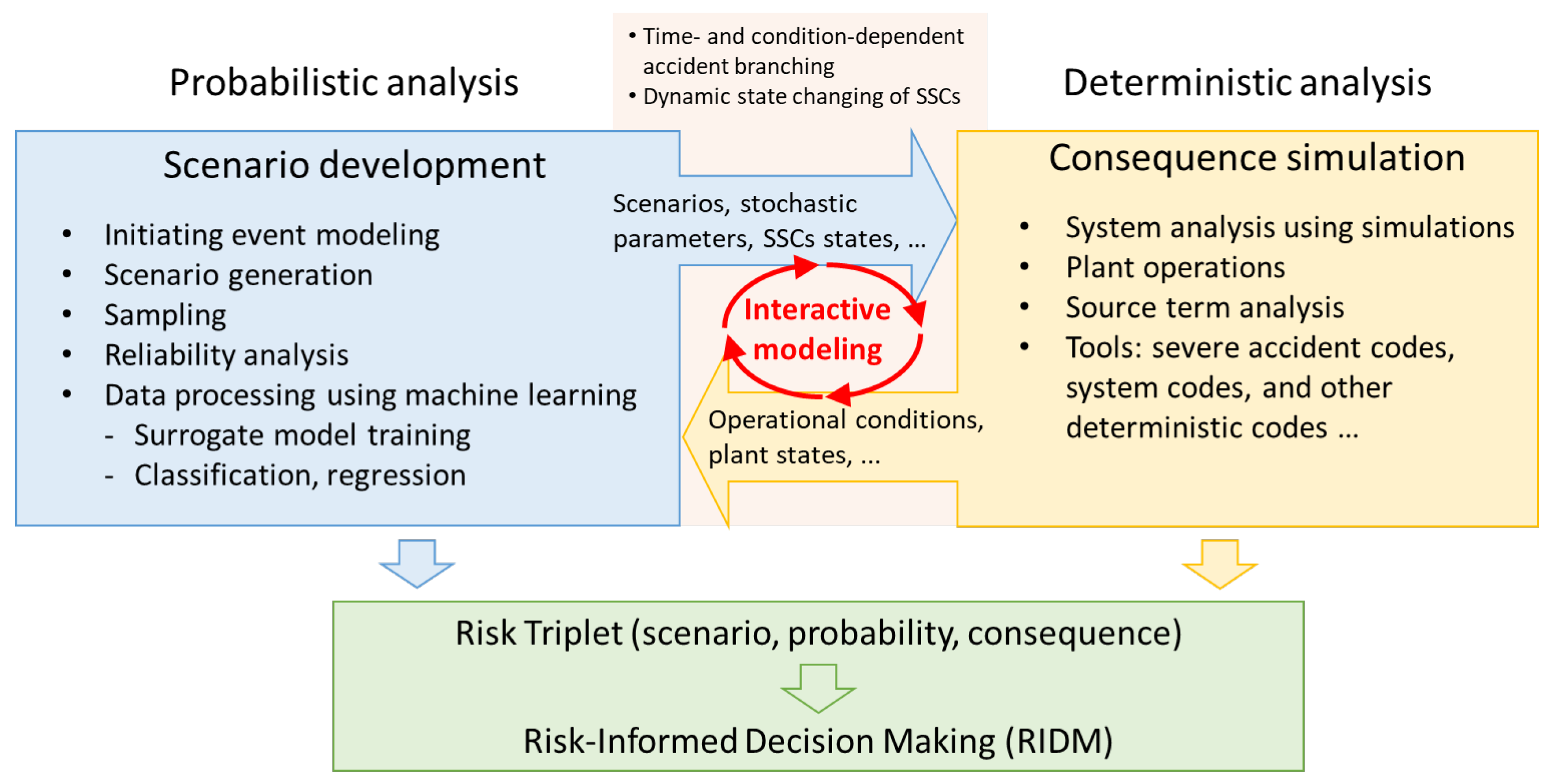
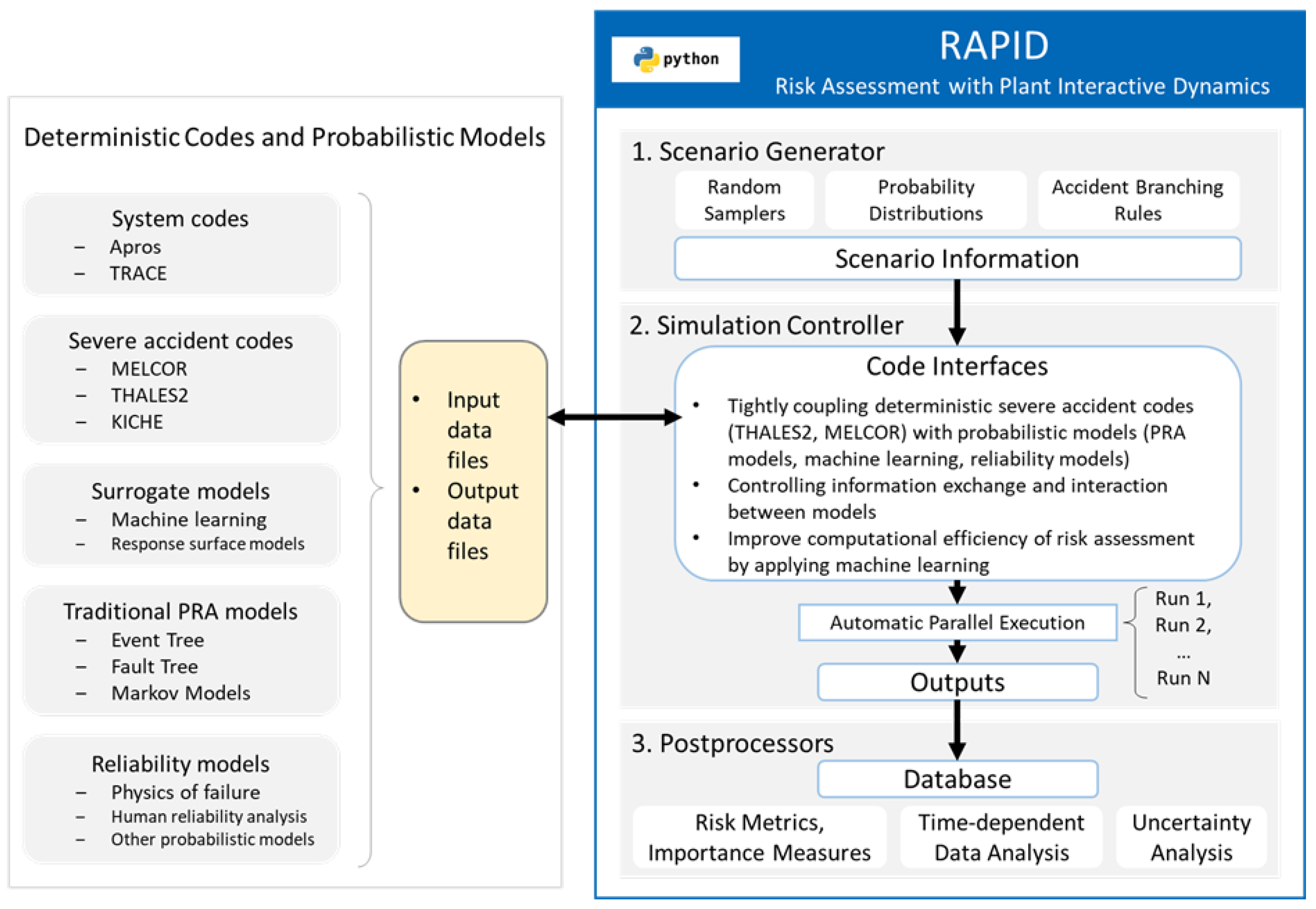
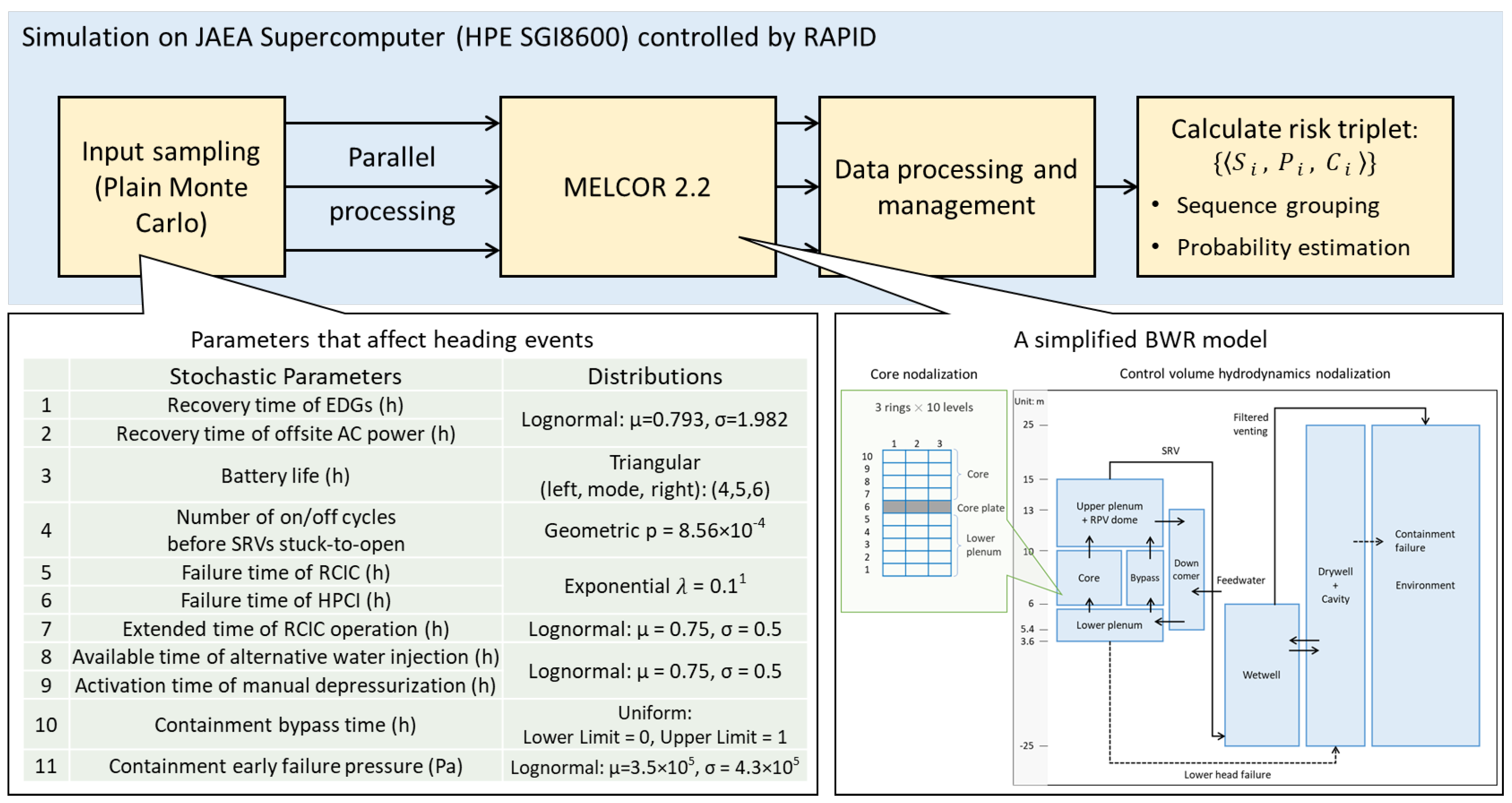
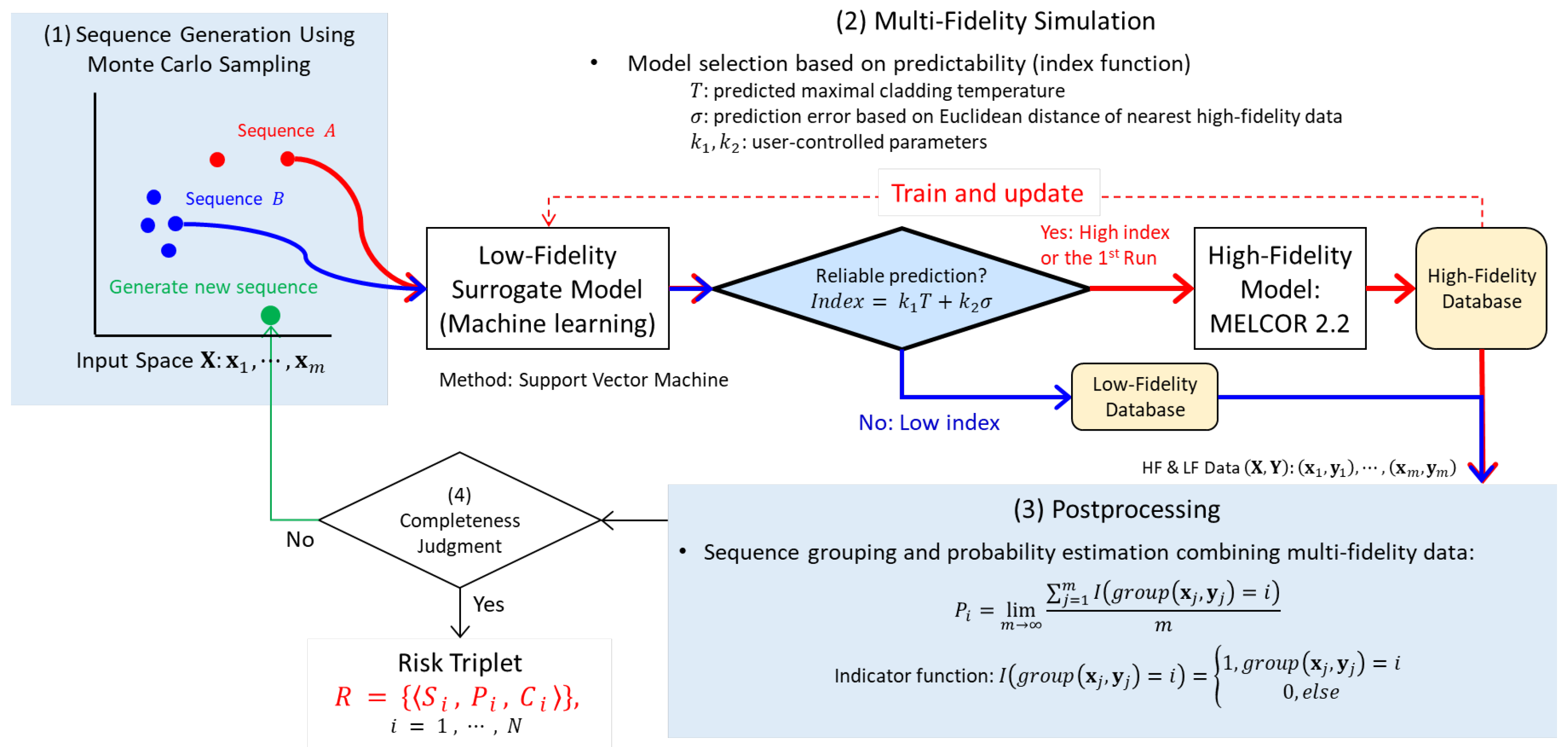

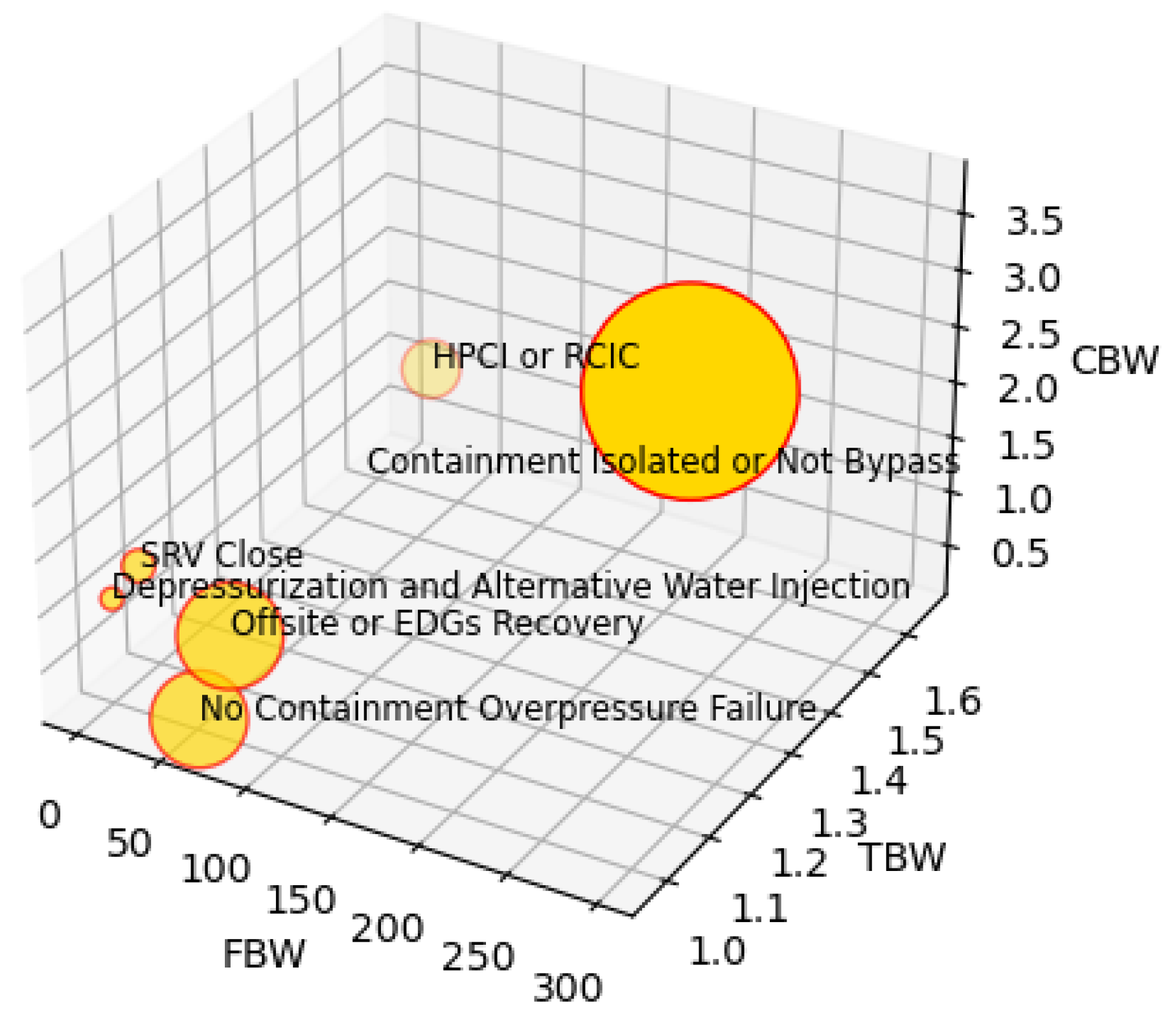
| Risk-Informed Regulatory Activities | Representative RIMs | References | |
|---|---|---|---|
| 1 | Risk-informed SSC categorization and treatment of SSCs for nuclear power reactors | FV, RAW | 10 CFR 50.69 [10] NEI 00-04 [12] |
| 2 | Risk-informed changes to technical specifications, evaluation of completion time and surveillance frequency | ICDF, ILERF, incremental core damage probability (ICDP), incremental large early release probability (ILERP) | USNRC RG 1.177 [24] NEI 06-09 [25] NEI 04-10 [26] |
| 3 | Maintenance rule | RRW, RAW, CDF contribution (ranking of cut sets inclusion) | 10 CFR 50.65 [6] USNRC RG 1.160 [27] NUMARC 93-01 [28] |
| 4 | Reactor oversight process: significance determination process, inspection planning | ∆CDF, ∆LERF | NUREG-1649 [7] USNRC Inspection Manual |
| 5 | Licensing application activities of small modular reactors | Birnbaum, FV, RRW, RAW | Design certification applications [31]: NuScale VOYGR, Westinghouse AP300, HOLTEC SMR-160 |
| Event-Tree Headings | TBW | FBW | CBW |
|---|---|---|---|
| SRV Close | 1.044 | 4.888 | 1.156 |
| HPCI or RCIC | 1.656 | 19.28 | 0.990 |
| Depressurization and Alternative Water Injection | 0.999 | 1.297 | 1.000 |
| Offsite or EDGs Recovery | 0.999 | 71.53 | 1.000 |
| Containment Isolated or Not Bypass | 1.128 | 298.1 | 3.707 |
| No Containment Overpressure Failure | 0.971 | 59.61 | 0.289 |
Disclaimer/Publisher’s Note: The statements, opinions and data contained in all publications are solely those of the individual author(s) and contributor(s) and not of MDPI and/or the editor(s). MDPI and/or the editor(s) disclaim responsibility for any injury to people or property resulting from any ideas, methods, instructions or products referred to in the content. |
© 2025 by the authors. Licensee MDPI, Basel, Switzerland. This article is an open access article distributed under the terms and conditions of the Creative Commons Attribution (CC BY) license (https://creativecommons.org/licenses/by/4.0/).
Share and Cite
Zheng, X.; Tamaki, H.; Sibamoto, Y.; Maruyama, Y.; Takada, T.; Narukawa, T.; Takata, T. Development of Importance Measures Reflecting the Risk Triplet in Dynamic Probabilistic Risk Assessment: A Case Study Using MELCOR and RAPID. J. Nucl. Eng. 2025, 6, 21. https://doi.org/10.3390/jne6030021
Zheng X, Tamaki H, Sibamoto Y, Maruyama Y, Takada T, Narukawa T, Takata T. Development of Importance Measures Reflecting the Risk Triplet in Dynamic Probabilistic Risk Assessment: A Case Study Using MELCOR and RAPID. Journal of Nuclear Engineering. 2025; 6(3):21. https://doi.org/10.3390/jne6030021
Chicago/Turabian StyleZheng, Xiaoyu, Hitoshi Tamaki, Yasuteru Sibamoto, Yu Maruyama, Tsuyoshi Takada, Takafumi Narukawa, and Takashi Takata. 2025. "Development of Importance Measures Reflecting the Risk Triplet in Dynamic Probabilistic Risk Assessment: A Case Study Using MELCOR and RAPID" Journal of Nuclear Engineering 6, no. 3: 21. https://doi.org/10.3390/jne6030021
APA StyleZheng, X., Tamaki, H., Sibamoto, Y., Maruyama, Y., Takada, T., Narukawa, T., & Takata, T. (2025). Development of Importance Measures Reflecting the Risk Triplet in Dynamic Probabilistic Risk Assessment: A Case Study Using MELCOR and RAPID. Journal of Nuclear Engineering, 6(3), 21. https://doi.org/10.3390/jne6030021







